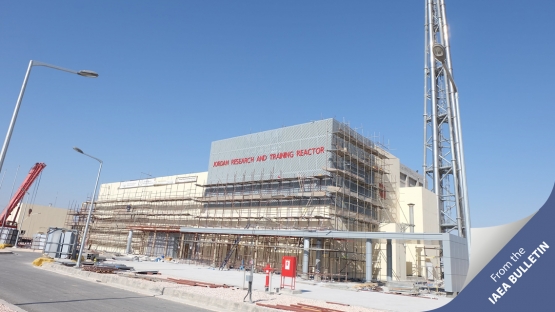As the world anticipates the climate policies that will unfold following the 2015 Paris Agreement and the adoption of the Sustainable Development Goals (SDGs), more countries are likely to include nuclear power in their national energy mixes. Newcomer States — countries introducing nuclear power for the first time — are requesting the IAEA’s assistance in developing the proper infrastructure to establish safe, secure and sustainable nuclear power programmes and cope with the challenges posed by the rise in global demand for energy and the need to mitigate climate change.
“The potential role for nuclear energy has greatly increased since the historic adoption of the SDGs and the Paris Agreement,” said David Shropshire, Head of the IAEA’s Planning and Economic Studies Section. “The decision to use nuclear is now easier since there are only a few other large-scale, uninterrupted energy options that come with small environmental footprints.”
The Paris Agreement was adopted at the Paris Climate Change Conference (COP21), at which 195 countries agreed to the first universal, legally binding agreement on climate. The Agreement confirmed the target of keeping the rise in global temperature below 2 degrees Celsius by the end of the century as compared to preindustrial times.
To address this target and the energy–climate challenge (see The energy–climate challenge), several countries are re-evaluating their energy mixes and the potential role of nuclear energy. “Instead of being recognized as just a power source to propel economies, nuclear is now linked to climate action,” Shropshire said. “Countries investing in nuclear power not only get dependable energy but also a key resource to not exceed the 2 ̊C target.”
The Polish answer
Poland, for example, plans to generate nuclear power, not only to ensure long term electricity supply and stimulate national economic growth, but also to mitigate climate change.
“Poland recognizes the importance of the Sustainable Development Goals, including the reduction of emissions of carbon dioxide and other air pollutants from the energy sector,” said Józef Sobolewski, Director of the Nuclear Energy Department at Poland’s Ministry of Energy. “Part of our strategy stipulates that introducing nuclear power — a zero-emission, clean and efficient energy source — is one of the means to achieve that reduction.” A nuclear power programme would also be a strong stimulus for the domestic research and development sector, he added.
The IAEA is an essential resource hub for newcomer States such as Poland and other countries considering nuclear power. They can access the IAEA’s energy planning tools and tap into its knowledge of nuclear power to make informed decisions about the role of this energy source in their countries.
“Once a Member State decides to use nuclear power, the IAEA can provide advice and review the development of the required infrastructure,” Shropshire said.
Reaching milestones step by step
The IAEA’s three-phase ‘Milestones approach’ facilitates the implementation of a nuclear power programme from start to finish. This includes issues for consideration by a Member State before deciding to build a nuclear power plant (NPP), the preparations involved and the construction and commissioning of the NPP. To complement this, Member States often request an Integrated Nuclear Infrastructure Review (INIR) mission, where international experts determine whether the programme is based on an effective national policy and strategy, strong management, a proper legal framework and a skilled workforce. Drawing on this review, the IAEA develops a country- specific integrated work plan to assist newcomer States in addressing gaps in their nuclear infrastructure and conducts follow-up reviews to track their progress.
Poland reached the first milestone this year after implementing the IAEA’s recommendations based on the INIR missions conducted during Phase 1 of the Milestones approach. The country aims to complete construction of the first reactor of its first NPP by 2024 and begin the construction of a second NPP by 2030. A Phase 2 INIR mission is expected to take place in 2017 to review Poland’s progress with its nuclear power programme.
Toward sustainable energy in Jordan
Among other newcomer States, Jordan included nuclear power in its national strategy to mitigate carbon emissions.
“Jordan’s energy is almost totally dependent on imported fossil fuel, which cannot be sustainable for various reasons,” said Khaled Toukan, Chairman of the Jordan Atomic Energy Commission. “The establishment
of a nuclear power plant, among other alternatives, will have a significant positive impact on Jordan from the standpoints of energy cost and reliability, national income, human infrastructure and expertise building, as well as carbon emission reduction.”
Upon Jordan’s request, the IAEA has already conducted three INIR missions since 2009 and has provided Jordan with an action plan based on an evaluation of the country’s nuclear infrastructure and the regulatory framework for nuclear and radiation safety. This year, Jordan will commission its first research and training reactor, and the IAEA will assist the country in building its capacity for future operation and effective utilization.
Nuclear power is also included in Turkey’s energy strategy to mitigate climate change, according to Turkey’s ‘Intended Nationally Determined Contributions’ report submitted under the United Nations Framework Convention on Climate Change. Through INIR missions, the IAEA has assisted Turkey in evaluating its readiness to develop a nuclear power programme. Upon Turkey’s request, IAEA experts provided recommendations for a national action plan and also reviewed the country’s draft nuclear energy laws. Turkey plans to build two NPPs with eight reactors to be operational by 2028 and to start building a third by 2023.
Poland recognizes the importance of the Sustainable Development Goals, including the reduction of emissions of carbon dioxide and other air pollutants from the energy sector. Part of our strategy stipulates that introducing nuclear power — a zero-emission, clean and efficient energy source — is one of the means to achieve that reduction.







